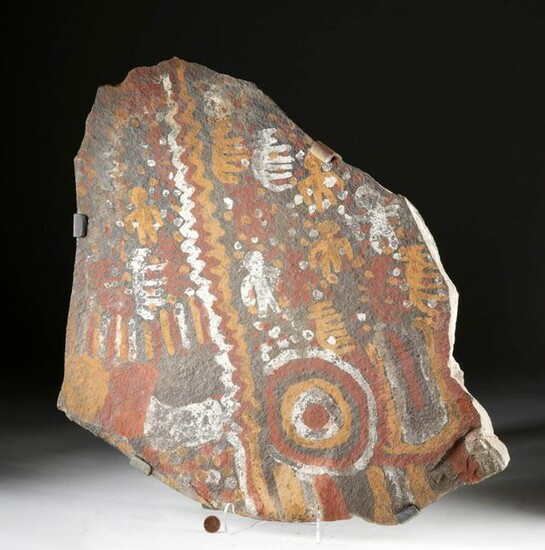Massive Inca Chucu Painted Stone Plaque Petroglyphs
Pre-Columbian, southern Peru, Inca hinterlands (Chucu), ca. 1000 to 1500 CE. A beautiful stone plaque, of a large and oblong form. The plaque depicts an intricate abstract scene of humans standing among a field of four-legged animals, perhaps goats or llamas, with two decorative halves divided by a vertical band of concentric zigzags in pigment of natural white, yellow, and red hues. The left half of the composition shows a lone yellow figure standing in a stippled field with four animals above a band of polychrome frets, and the right shows six humans and five animals above a wide concentric circle and a larger band of frets. Size: 20" W x 21.5" H (50.8 cm x 54.6 cm).
These plaques were made by smashing large vessels and painting the fragments. They have been discovered in a number of different contexts: beneath wall foundations, in graves, with animal sacrifices, and cached in prominent places in the landscape, like in springs, rock hollows, and atop hills. They are often discovered in pairs, with the painted surfaces placed so that they are facing each other, sometimes wrapped in leaves or even gold sheet. Although the tablet tradition began centuries before, the time period that this one comes from represents the height of the artform, and corresponds to an intensification of agriculture, the rise of interregional trade networks, and the ascendancy of certain important confederations of clans. Into this potent mix, the Inca expanded into the region and the tablet tradition abruptly ended. It seems likely that the Inca, who colonized regions in part by sponsoring local ritual activities, outlawed the creation of religious tablets like this because they saw them as a threat to their trade in sacrificial alpacas, corn beer, and cloth.
Provenance: private Hawaii, USA collection; ex-private Hillberg collection, Sonoma County, California, USA, acquired between 1960 and 1970
All items legal to buy/sell under U.S. Statute covering cultural patrimony Code 2600, CHAPTER 14, and are guaranteed to be as described or your money back.
A Certificate of Authenticity will accompany all winning bids.
We ship worldwide to most countries and handle all shipping in-house for your convenience.
#146159
Condition Report: This is a fragment of a larger piece. Minor chips along peripheries and verso, with light fading to original pigmentation, and light encrustations, otherwise intact and excellent. Nice earthen deposits and traces of original pigmentation throughout. Mounted with modern metal bracket for display. Old inventory label on verso.
View it on
Estimate
Time, Location
Auction House
Pre-Columbian, southern Peru, Inca hinterlands (Chucu), ca. 1000 to 1500 CE. A beautiful stone plaque, of a large and oblong form. The plaque depicts an intricate abstract scene of humans standing among a field of four-legged animals, perhaps goats or llamas, with two decorative halves divided by a vertical band of concentric zigzags in pigment of natural white, yellow, and red hues. The left half of the composition shows a lone yellow figure standing in a stippled field with four animals above a band of polychrome frets, and the right shows six humans and five animals above a wide concentric circle and a larger band of frets. Size: 20" W x 21.5" H (50.8 cm x 54.6 cm).
These plaques were made by smashing large vessels and painting the fragments. They have been discovered in a number of different contexts: beneath wall foundations, in graves, with animal sacrifices, and cached in prominent places in the landscape, like in springs, rock hollows, and atop hills. They are often discovered in pairs, with the painted surfaces placed so that they are facing each other, sometimes wrapped in leaves or even gold sheet. Although the tablet tradition began centuries before, the time period that this one comes from represents the height of the artform, and corresponds to an intensification of agriculture, the rise of interregional trade networks, and the ascendancy of certain important confederations of clans. Into this potent mix, the Inca expanded into the region and the tablet tradition abruptly ended. It seems likely that the Inca, who colonized regions in part by sponsoring local ritual activities, outlawed the creation of religious tablets like this because they saw them as a threat to their trade in sacrificial alpacas, corn beer, and cloth.
Provenance: private Hawaii, USA collection; ex-private Hillberg collection, Sonoma County, California, USA, acquired between 1960 and 1970
All items legal to buy/sell under U.S. Statute covering cultural patrimony Code 2600, CHAPTER 14, and are guaranteed to be as described or your money back.
A Certificate of Authenticity will accompany all winning bids.
We ship worldwide to most countries and handle all shipping in-house for your convenience.
#146159
Condition Report: This is a fragment of a larger piece. Minor chips along peripheries and verso, with light fading to original pigmentation, and light encrustations, otherwise intact and excellent. Nice earthen deposits and traces of original pigmentation throughout. Mounted with modern metal bracket for display. Old inventory label on verso.



